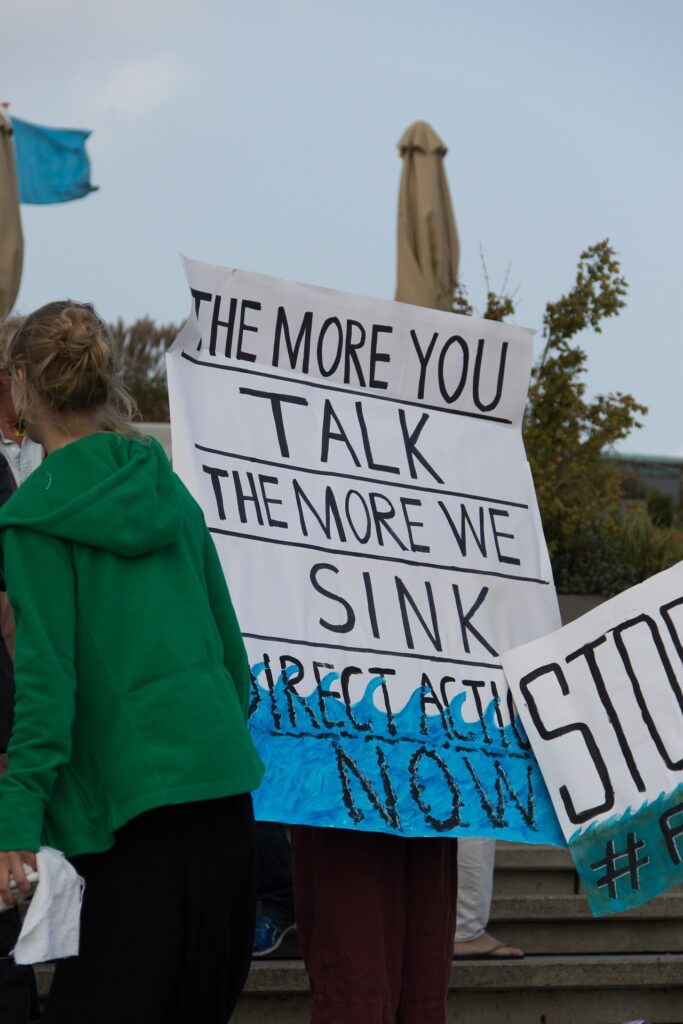This article is part of a series republished via the Council of Business and Society platform.
Discussions at the Davos 2021 Summit made our global roadmap crystal clear: it’s prime time for a Great Reset. That said, the equation is far from simple. We must kickstart our climate transition despite the equally clear prospect of social unrest. This can only make climate transitioning as indispensable as it is delicate. In 2021 more than ever, we at Ksapa stand by the concept of Just Transitions. We contend Boards play a key role in convincing businesses to adopt a Just Transition lens in their climate strategies.
Corporations Pressured to Deliver Both on Climate and Social Justice
Stepping Up Climate Ambitions In The Face of A Social Emergency
The Great Reset discussed at the Davos 2021 Summit is a commitment to jointly and urgently (re)build the foundations of our socio-economic system. The goal? Securing a fairer, more sustainable and resilient future. This rallying call was likely fed and reinforced by the following key trends:
- The EU Commission is currently holding a public consultation on sustainable corporate governance. In France, the Central Bank is demonstrating clear leadership in moving beyond coal and capping oil and gas investments.
- The UK announced plans to mandate financial disclosures by 2025 following recommendations of the Task Force on Climate-related Financial Disclosures.
- The Biden administration reunited with collaborative climate action. Not only that, it is matching global commitments with a bold domestic program to incentivize business accordingly.
None of that is near enough. While the G20 accounts for 2/3 of the world’s population, it is driving 50% more stimulus money towards fossil fuels, not low-carbon alternatives. There is a straightforward reason for that: jobs, jobs, jobs. Exploiting an oil field may not be good for the climate, but it creates massive employment and tax opportunities. Conversely, it is all very well and good for a wind farm to match the ambitions of the Paris Accord. Still, it leaves far more people aside while generating far less fiscal resources…
Understanding the Implications of Just Transitions
Tackling climate action is obviously complex. One reason for that is that it so fundamentally supersedes individual interests. Our intrinsic dilution of responsibilities makes it easier to pass the buck over to other stakeholders.
As such, Just Transitions are a way for us to collectively adapt to the new climate emergency, in the most inclusive manner possible. What does inclusion have to do with it, you ask?
First of all, because the climate issue requires a collective effort, inclusion is necessarily the way forward. When it comes to climate, individual efforts can only be encouraged. That said, if they fail to partake in a more collective logic, it is unfortunately will not cut it.
Second, just consider the discrepancies observed between a 1.5 or 2 degree IPCC trajectory. The climate shock at hand is such that without an inclusive approach, the climate transition only fuels major conflicting dynamics. That can only be counterproductive at the very time we need more alignment, not less.
Multiple recent social movements showcased both. In France, for instance, the Yellow Vests resisted a carbon tax they deemed unfair, sparking further conflict around sustainability. They eventually forced the State to wipe the slate clean on the intended the carbon tax. This just as putting a price on carbon would contribute to making great strides toward our climate transition!
Reflecting on Just Transitions effectively moves the needle away from the collective dilution of climate responsibilities. It guides us into a dynamic of joint responsibility rallying local stakeholders.
Ksapa’s 4-Step Plan for Boards to Boost Just Transitions
Momentum around Building Back Better is growing as political and financial imperatives increasingly align. According to a Boston Consulting Group study, 50% of US investors support companies pursuing their ESG priorities amid the crisis. This, at the expense of earnings… to an extent. Household names – including Microsoft, Starbucks, Shell and BNP Paribas – heeded the trend, announcing plans to cut emissions or otherwise safeguard the environment.
In broader terms, there is a growing aspiration across many sectors of society to derive lessons from Covid-19. Predictable but inadequately addressed high impact events – like pandemics or climate change – may indeed exact huge costs. So businesses must play their part. Boards of Directors in turn have a prime responsibility to steer companies safely through climate change and other systemic externalities.
For boards seeking broader consensus on the matter, Ksapa outlines a 4-step plan for Boards to boost Just Corporate Transitions.
1. Start with Vision, Purpose and Mission
At Ksapa, we find clients often confuse mission, vision and purpose statements. We clarify how best to proceed in a recent briefing paper. Some organizations make do with a mission statement. Others operate with mission and vision statements. Others yet outline a purpose. Finally, some use altogether different terms to describe their mission, vision or purpose. Some organizations mix these concepts up and end up publishing a mission statement that is basically a vision, or amalgamate their vision and purpose.
Confusion is indeed a problem when mission, vision and purpose statements lack clarity and uniqueness. The same concepts can be extremely powerful, provided they are sharp, unique. They must be supportive of a collective alignment around what an organization stands for. It comes down to how people from varying walks of life can be made to feel they directly contribute to a project much bigger than themselves.
Finally, these concepts garner even greater meaning when articulated with the UN 2030 Sustainable Development Goals. That however implies steering clear of SDG-Washing. Ksapa formalized a briefing paper to outline how to explore these actionable convergences. Just Corporate Transitions in fact call for businesses to develop a much clearer a vision and organizational capacity to connect the dots. What is its role in society? Just how does it address climate change while carefully including and managing people? Only then can business secure the social acceptability of its activities.
2. Build Board Level Alignment on Companies’ Key Sustainability Challenges
Given the currently uncertain times they face, many boards are in survival mode. The risk is they solely focus on the short-term, devoting little time for more future-forward considerations. It is certainly the feedback we are getting or managing across our various engagements. The role of a Board of Directors lies elsewhere, however.
If nothing else, Boards convey a strategic perspective and long-term vision for the company they steer. Not only is sustainability obviously not their sole priority, it is likely one of the least consensual dimension of their work. This may signal serious misalignment and little shared understanding among Board members.
How to Create Board Consensus Around Just Transitions
Countering this tendency, it is essential Boards align behind priority sustainability themes and their potential business implications. Such a meeting could very well focus on the following agenda:
- Explore material sustainability themes for the industry and discuss business implications;
- Understand how the company actually addresses such issues, with what data and level of comparability vis-à-vis its peers;
- Build a strong business case Board member can share into, in order to identify risks and opportunities in the medium and long-term;
- Explore gaps and press corporate management to address them;
- Strengthen dashboards and data communicated to the Board;
- Explore unknown and “black swan” scenarios as a way to encourage management to improve its agility on these critical considerations.
As controversial as it may sound, pandemic risks have been included in risk maps for more than a decade. At the time, this simply did not constitute a black swan scenario. Overall, pandemic risks were not sufficiently managed. Now, the 2021 WEF Global Risk Report shows numerous other issues on our collective horizon, from terrorism to contentious geopolitics, climate impacts, social unrest, biodiversity depletion, water stress. Bear in mind most of these impending crises could very well work in combination.
With that in mind, a Just Transitions agenda would advantageously encourage companies to explore whether and how broad social anger at the macro level could very well impact micro business operations. The key question for companies is then to consider just what they can do to effectively adapt to ongoing social volatility.
3. Increase Board Diversity to Update Expertise and Outlook
The Harvard Business Review offers a fascinated read on sustainability archetypes prevalent among Board Members. We at Ksapa are all too often surprised to find ourselves engaging with those who would deny the correlation between financial and non-financial performance. We generally respond that a company can only achieve economic performance if it closely aligns with market expectations. Markets are unmistakably shaped by sustainability… among other things. Company health is therefore tied to non-financial performance.
We of course back this up with concrete case studies and examples we have collected over time and through a diversity of expertise. Such is indeed the best way to engage other Board members directly, tapping into their own experience and background. The goal is to remain realistic, concrete and grounded in what really matters to the company at hand.
How to Ramp Up Board Diversity and Expertise
Another way forward lies in involving a third party to conduct an objective assessment of Board expertise. Provided that expertise is topical and sufficiently diverse, Board Members may effectively steer the company’s vision and ambition, especially insofar as it relates to its priority sustainability issues.
We encourage Boards to step up diversity, starting with genuinely addressing the following questions:
- Given sustainability themes present high risks and/or opportunities for the company, do we as Board Members have the right expertise or network across board members or its close networks to conduct our critical assessment? How then do we collectively analyze strategies, processes, investment decisions (including joint venture operations), innovations, mergers and acquisitions?
- Have we reached a balanced perspective across a spectrum of board members eager to encourage bold transformations and those perhaps more skeptical? Does this allow us to conduct a careful review and outline clear business cases. Does this help us reach decisions for our company that are grounded in real-world data and tangible facts?
- If there are gaps, what would be the ideal profile to onboard to stretch our Board’s diversity of expertise, viewpoint and mindset. Who can help us improve our collective understanding of the issues at stake?
Including workers’ perspectives during Board discussions is also good practice. This basically lends Board Members a prime sound board, that is, a way to embed employee viewpoints in strategic – or perhaps more operational – board-level interactions. When this isn’t the case, other options may work as well. We at Ksapa have for instance facilitated Board-level engagement with stakeholder panels. This approach in fact complements their perspectives, by reinforcing their understanding of key expectations – from employees to civil society organizations, business partners and other key stakeholders.
4. Improve Board Agility to Manage Volatile Business Environments
Social volatility is by essence not predictable. Consider the Arab Spring. I was working with several telecom companies at that time and did not anticipate the revolutionary surge. I was just as far from imagining the unethical decisions several clients would have to make to abide by government directives. The latter included suspending the Internet or collecting data on individuals joining the protests.
In that scenario, a company’s Board of Directors would necessarily be involved. Being effective in critical times implies the company has laid the organizational groundwork and preparation on a continual basis. This in turns calls for Board decisions to embed socio-environmental considerations in any and all decision-making process.
How to keep learning and building collective understanding
The issues at stake are particularly multifaceted. If Board members think one meeting suffices to cover the nuances and multiple implications of climate change across their business, they have a problem. We all learn as we go and managing this learning curve necessarily rhymes with continuous vigilance.
That said, here are key practices we recommend:
- Schedule regular cross-cutting updates on science, innovation, peer initiatives or regulations;
- Invite experts to discuss specific topics to strengthen collective knowledge;
- Set up a specific process to plan and adapt to a range of critical events on different timescales, including in times of crisis;
- Consider setting up an independent stakeholder panel to assess Board decisions and overall progress against a Just Transition Agenda.
Given this wide array of interrogations, we can offer no silver bullet. It is however good practice to basically take the time to learn from critics, scandals and failures. Working with multinationals, Ksapa regularly highlights major socio-environmental crises as unique opportunities to identify core issues. That way we work with our clients to substantially improve corporate policies, processes and tools.
Conclusion: Work at the Interface of Climate and Social Issues to Identify Way Forward
This proposed 4-step plan is intended to help Boards develop a comprehensive view of steering Just Transition. By this we refer to launching a transformative journey for companies. This starts and ends with better addressing the pressing sustainability challenges impacting the communities in which they operate. Solving this equation it the key for Boards to successfully drive much-needed corporate transformations. Faced with profound socio-environmental upheavals, they must anticipate the stakes can only be heightened by the still ongoing sanitary crisis.
Author of several books and resources on business, sustainability and responsibility. Working with top decision makers pursuing transformational changes for their organizations, leaders and industries. Working with executives improving resilience and competitiveness of their company and products given their climate and human right business agendas. Connect with Farid Baddache on Twitter at @Fbaddache.





